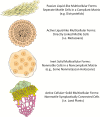The many roads to and from multicellularity
- PMID: 31819969
- PMCID: PMC7289717
- DOI: 10.1093/jxb/erz547
The many roads to and from multicellularity
Abstract
The multiple origins of multicellularity had far-reaching consequences ranging from the appearance of phenotypically complex life-forms to their effects on Earth's aquatic and terrestrial ecosystems. Yet, many important questions remain. For example, do all lineages and clades share an ancestral developmental predisposition for multicellularity emerging from genomic and biophysical motifs shared from a last common ancestor, or are the multiple origins of multicellularity truly independent evolutionary events? In this review, we highlight recent developments and pitfalls in understanding the evolution of multicellularity with an emphasis on plants (here defined broadly to include the polyphyletic algae), but also draw upon insights from animals and their holozoan relatives, fungi and amoebozoans. Based on our review, we conclude that the evolution of multicellular organisms requires three phases (origination by disparate cell-cell attachment modalities, followed by integration by lineage-specific physiological mechanisms, and autonomization by natural selection) that have been achieved differently in different lineages.
Keywords: Volvox; Algae; evolution; fungi; land plants; metazoans; multilevel selection theory; unicellular bottleneck.
© The Author(s) 2020. Published by Oxford University Press on behalf of the Society for Experimental Biology.
Figures
References
-
- Bonner JT. 1998. The origins of multicellularity. Integrative Biology 1, 27–36.
-
- Bonner JT. 2009. The social amoebae: the biology of cellular slime molds. Princeton: Princeton University Press.
-
- Bonner JT. 2013. Randomness in evolution. Princeton: Princeton University Press.
-
- Bourrat P. 2015. Levels, time and fitness in evolutionary transitions in individuality. Philosophical and Theoretical Biology 7, e601.
Publication types
MeSH terms
LinkOut - more resources
Full Text Sources


